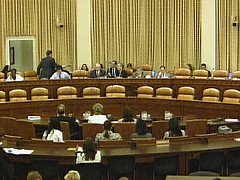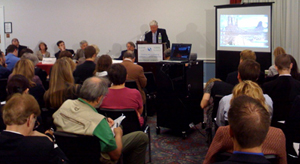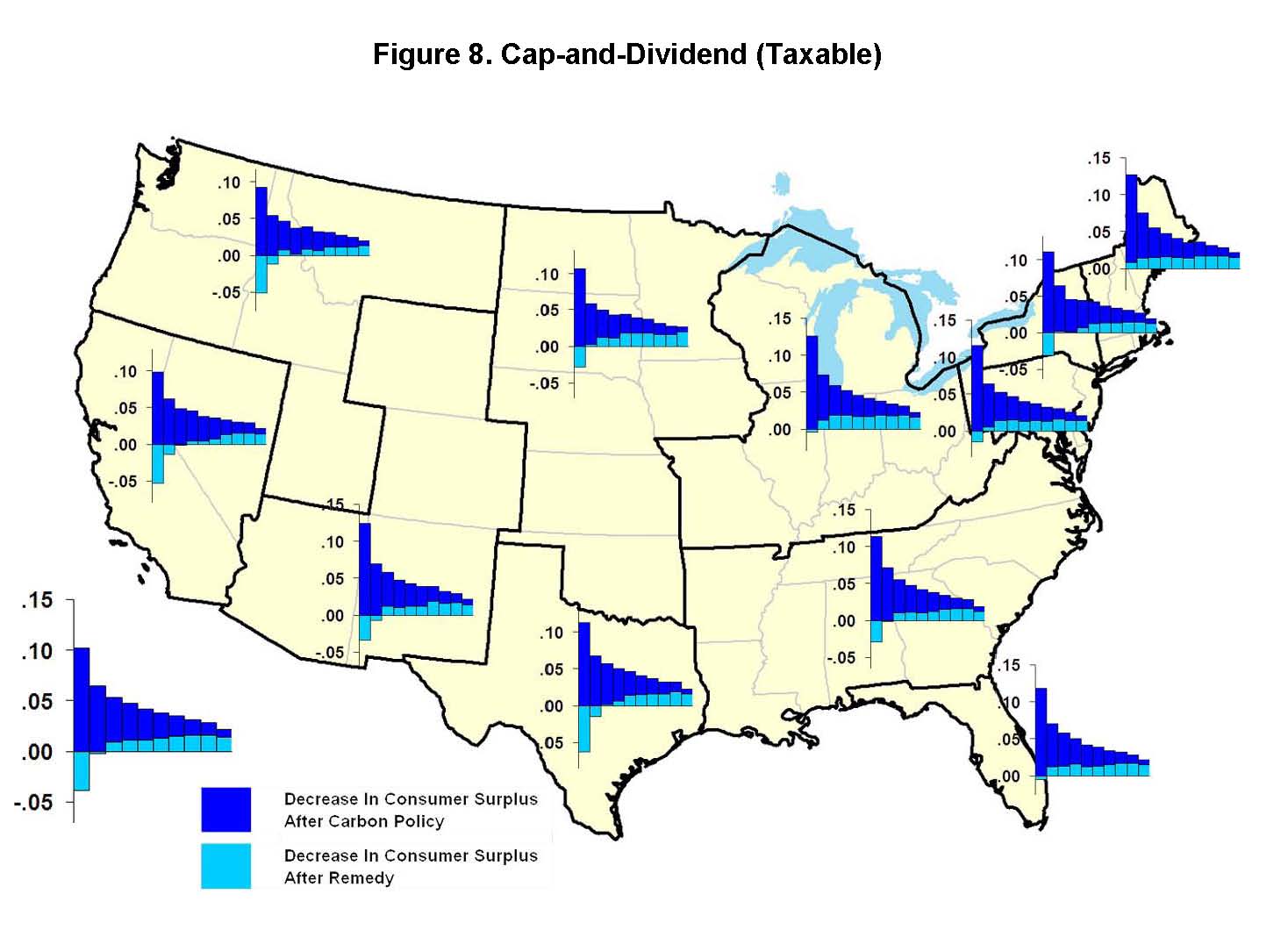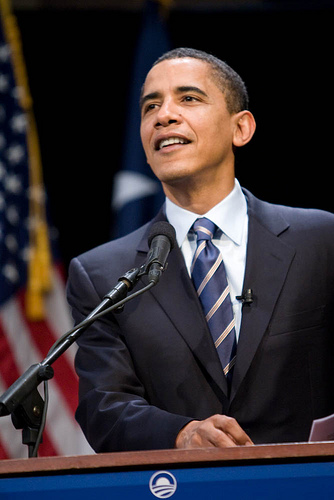Why Revenue-Neutral Carbon Taxes are Superior to “Cap and Trade” Schemes (Seeker Blog)
Search Results for: revenue
Bloomberg, Economists, Greens Tell Ways & Means: Price Carbon Upstream, Distribute Revenues to Consumers
Reported for the Carbon Tax Center by James F. Handley.
The "fierce urgency" of the climate crisis compels action, said Rep. John Larson (D-CT) at Thursday’s House Ways and Means Committee’s packed hearing on climate change revenue measures. Hurricane Ike’s devastation of coastal Texas imparted deeper meaning to Martin Luther King’s phrase. Witnesses pointed to storm-related damage as one of many ways in which failure to reduce the greenhouse gas emissions that drive global warming will destroy ecosystems and economies alike.
Citing the effectiveness and simplicity of a carbon tax, New York City Mayor Michael Bloomberg urged Congress to tax fossil fuel producers upstream, and distribute revenue downstream to consumers by reducing payroll taxes. A carbon tax would impose a cost proportional to carbon emissions, but because revenue distribution would not be linked to consumption, the system would “use capitalism” to create broad incentives for energy conservation and alternative energy, Bloomberg said.
 While reiterating that he favors a “straightforward carbon tax,” Bloomberg said carbon cap-and-auction would also work if revenues were distributed downstream, an idea elaborated later by Peter Barnes of Cap and Dividend. Bloomberg urged the U.S. to avoid competing to become the world’s cheapest producer — a strategy that has thrust China into an environmental nightmare and a downward wage spiral. Bloomberg and Dr. Frank Ackerman of the Stockholm Environment Institute and Tufts University cited Germany’s standing as a world leader in manufacturing high-value products despite high wages and energy prices.
While reiterating that he favors a “straightforward carbon tax,” Bloomberg said carbon cap-and-auction would also work if revenues were distributed downstream, an idea elaborated later by Peter Barnes of Cap and Dividend. Bloomberg urged the U.S. to avoid competing to become the world’s cheapest producer — a strategy that has thrust China into an environmental nightmare and a downward wage spiral. Bloomberg and Dr. Frank Ackerman of the Stockholm Environment Institute and Tufts University cited Germany’s standing as a world leader in manufacturing high-value products despite high wages and energy prices.
Climate policy, said Dr. Peter Orszag of the Congressional Budget Office, poses the thorny problem of imposing short-term costs to achieve long-term benefits. The Lieberman-Warner cap-and-trade bill would have created $100 billion in carbon emission allowances. Orszag stressed that giving away permits to energy producers, as the bill proposed, would enrich fuel producers rather than protect energy consumers. To avert the extreme volatility experienced under EPA’s sulfur dioxide cap and maximize economic efficiency, Orszag urged that a carbon cap be designed flexibly with banking of permits.
Dr. Dallas Burtaw of Resources for the Future agreed with Orszag that giving away permits to energy producers wouldn’t reduce price increases felt by consumers. A tax with a direct dividend would function as a transparent system, Burtaw said, that would signal to the public that we are addressing climate change as a national initiative that is “not engineered to squirrel away special privileges.”
Tim Regan of Corning Incorporated warned the Committee over the competitive disadvantage to energy-intensive industries such as his own under either cap-and-trade or a carbon tax. But Robert Lighthizer, an attorney with Skadden, Arps’ international trade department, assured the panel that the WTO allows the U.S. to impose tariffs equivalent to domestic carbon prices on imported products to put domestic products on a level playing field. Gary Hufbaur of the Peterson Institute cautioned that the WTO has not ruled on these matters but argued that this need not delay U.S. action to create incentives for our trading partners to join in combating global warming.
The Committee questioned panelists extensively. Rep. Paul Ryan (R-WI) cited the conclusion of the February CBO study that a carbon tax would be five times as effective as a simple cap-and-trade system. Several panelists noted that setting tariffs to harmonize the burden on imported goods would be much simpler under a carbon tax because the exact price of carbon would be fixed while under cap-and-trade the price would fluctuate.
After a recess for floor votes, the Committee began its second panel with Frank Ackerman of the Global Development and Environment Institute of Tufts University. “The debate has shifted at last” Dr. Ackerman declared. “Climate science is no longer debatable and now the serious economic discussion is underway.” He insisted that costs of inaction would be staggering — far more severe storm damage, sea-level rise inundating coastal-area homes, farms and businesses, particularly in Florida and the Caribbean, and endemic water shortages. Ackerman testified that the costs of well-designed policies to cut carbon would be small by comparison, probably only 1% of output.
Daniel Abassi of the emissions trading and investment firm MissionPoint Capital called on Congress to price carbon through a cap-and-trade system, with 25% of allowances given to industry and 75% auctioned, with revenue used to reduce distortionary taxes, for tax incentives, efficiency upgrades and low-carbon energy R&D.
The climate crisis is “a major threat to national security,” declared Jerome Ringo of the Apollo Alliance Having just been in Louisiana and Texas, Ringo said average people aren’t talking about the Wall Street meltdown, they’re asking “why they’ve been hit with so many category 5 storms; climate change comes up in almost every conversation.” Ringo called for Congress to push the U.S. to a green jobs economy by funding public transportation and infrastructure. He warned that emissions trading could mean “rich companies get richer” and asked that carbon revenues be dedicated to training and investment in alternative energy.
Peter Barnes urged Congress to put cap-and-trade auction revenue where it will do the most good both politically and economically — into a direct monthly dividend to each U.S. resident along the lines of the Alaska Permanent Fund. A dividend would offset economic effects on consumers and also build the broad political support needed to support climate legislation, Barnes said.
Expanding on the Apollo Alliance’s call for funding public transportation, Bill Millar of the American Public Transportation Association cited DOE studies showing that transport generates a third of U.S. carbon emissions. [Ed. note: autos and light trucks generate 21-22% of U.S. CO2; air travel and freight add another 10%, approximately.] “If a typical two-car, two-adult household chooses to eliminate one car and take public transportation, walk or ride a bicycle for most of its trips, [its] CO2 emissions can be reduced 30% which is more than if that household went without electricity,” Millar testified. Millar said that spending $1 billion on public transportation would create at least 35,000 jobs. He also called transit a direct way to offset the effects of higher fuel prices on consumers.
David Kreutzer of the Heritage Foundation testified that a U.S. policy capping emissions or a carbon tax would do little to reduce global greenhouse emissions and would not be worth the cost. Ackerman strongly disagreed, “If the U.S. leads, the world will follow, but if we don’t, the worst consequences” can be expected.
Photo: Flickr / HispanicCaucus.
Carbon Revenue Recycling is Focus of Capitol Hill Briefing
Reported for the Carbon Tax Center by James F. Handley
[Ed. note — two days after the Capitol Hill briefing, on Thurs. Sept. 18, the House Ways and Means Committee heard testimony on optimal pricing of carbon emissions, including a forceful presentation from carbon tax advocate New York City Mayor Michael Bloomberg; watch this space for CTC’s report.]
At least one Washington politician dares to say “tax” out loud — a carbon tax, no less.
Representative John Larson (D-Conn.) headlined a Capitol Hill panel discussion Tuesday and came out swinging for a revenue-neutral carbon tax. Larson, a member of the Democratic House leadership and the tax-writing Ways and Means Committee, called carbon taxing the most effective way to curb greenhouse gas emissions. Addressing a briefing organized by Clean Air – Cool Planet and the Energy and Environment Study Institute, the five-term Congressman invoked his constituents at Auggie & Ray’s Diner in East Hartford: “They know climate protection comes with a price tag — they want transparency up-front so they know what to expect and can plan ahead. And they want a fair, level playing field.”
Both a carbon tax or the auctioning of permits under a carbon cap-and-trade system would generate huge streams of revenue which would come under the jurisdiction of Ways and Means. The Committee has scheduled a hearing tomorrow, Sept. 18, on revenue recycling, and Larson will be on hand, presumably putting the spotlight on the American Energy Security Trust Fund Act he introduced in August 2007.
 Speaking to an overflowing House banquet room, Larson, shown at right, called a carbon tax “simple, efficient, straightforward and effective” and said it will be a boon to the economy if the revenue is recycled to reduce or eliminate distortionary taxes. Following Larson, a politically diverse panel of economists — Robert Repetto, Robert Shapiro, Terry Dinan, and Ken Green — discussed ways to maximize the “double dividend” — benefits to climate and to the economy from recycling revenue from either a carbon tax or the auction proceeds of cap-and-trade.
Speaking to an overflowing House banquet room, Larson, shown at right, called a carbon tax “simple, efficient, straightforward and effective” and said it will be a boon to the economy if the revenue is recycled to reduce or eliminate distortionary taxes. Following Larson, a politically diverse panel of economists — Robert Repetto, Robert Shapiro, Terry Dinan, and Ken Green — discussed ways to maximize the “double dividend” — benefits to climate and to the economy from recycling revenue from either a carbon tax or the auction proceeds of cap-and-trade.
Several noted the most egregious flaws of the defeated Lieberman cap-and-trade bill: it would have given away emission permits and auction revenues, mainly to fossil fuel industries, rather than recycling auction revenues downstream to consumers. Panelists noted that energy firms pass their costs downstream to consumers — who will need assistance. Only Repetto, of the UN Foundation, preferred cap-and-trade over a carbon tax, but with either, he wants a tax-shift — auctioning all permits and dedicating revenues to reduce other taxes.
Shapiro, a former Undersecretary of Commerce, warned of the costs and instability from price volatility under cap-and-trade, citing the U.S. acid rain program whose permit prices slosh around as much as 80% and the similarly volatile EU climate program which has achieved zero net greenhouse gas reductions. The morning after a disastrously volatile day on Wall Street, Shapiro called volatility the enemy of rational planning and efficient economic decision-making. Shapiro advocates recycling 90% of carbon tax revenue with the remaining 10% dedicated to R&D on low-carbon alternatives.
Dinan, author of a series of weighty CBO studies on climate policy documenting the advantages of a carbon tax, suggested ways to move cap-and-trade closer in efficiency to a carbon tax, for example by adding safety valves to limit price volatility. She underscored the efficiency advantages of applying revenues to reduce distortionary taxes such as payroll taxes, vs. distributing revenues equally with pro rata dividends. But Dinan and the new RFF study caution that unlike a straight dividend approach, tax-shifting out of payroll taxes would be acutely regressive, mainly because many low-income people, including elderly and the unemployed, don’t pay payroll taxes and thus wouldn’t benefit from payroll tax reductions. In contrast, dividends would go to everyone, equally, thus benefiting a clear majority of less-well-off individuals and households.
Ken Green, AEI resident economist and scientist who has written extensively about the “double dividend” from reducing distortionary taxes with carbon revenues, is rare among conservatives for supporting strong medicine to combat climate change. Because our entire society and every activity in it is built around energy consumption, changing energy prices will have profound effects, he noted, some of which must be offset. Green warned that politicizing climate change legislation or otherwise attempting to favor some constituents over others will “torpedo” the serious effort that is needed. Cap-and-trade hides the truth that we must use prices to change consumption patterns, said Green, and it will breed cynicism and undermine public support for climate protection. The public needs to understand that although fossil fuel prices will rise, they will be “made whole” as a group.
During Q&A an audience member noted the consensus for a carbon tax but asked panelists how a tax would provide the certainty that is often touted as the chief advantage of cap-and-trade. Shapiro suggested that carbon tax levels may need to be adjusted periodically to assure that emissions targets are being met. Green contended that powerful incentives for cheating and market manipulation will render cap-and-trade’s emissions certainty largely illusory. He called cap-and-trade a government-mandated constraint on supply, likening it to OPEC’s mission to limit oil supply to support prices. Just as in OPEC, cap-and-trade will bring irresistible temptation to cheat by selling outside the system and will eventually destroy public confidence, Green said.
Photo courtesy of Clean Air – Cool Planet
Think-Tank Gives Thumbs-Up to "Dividending" Carbon Revenues
Dividend? Yes.
Payroll tax-shift? No.
EITC tax-shift? Yes.
Energy-efficiency? Hmm, tell me more.
These are the bottom lines on carbon "revenue treatment," as we read them, of Resources for the Future’s impressive new report, The Incidence of U.S. Climate Policy. Released late last week, the report concludes that distributing carbon permit or tax revenues equally among U.S. residents would be income-progressive, whereas using the revenues to reduce payroll or income taxes would widen the already yawning income gap between rich and poor.
These findings appear just as serious attention is beginning to be paid in carbon-pricing circles to the disposition of the enormous revenues that would be raised under either a hefty carbon tax or a stringent carbon cap-and-trade system. Tomorrow, Sept. 16, the Energy and Environmental Study Institute and Clean Air – Cool Planet are co-hosting a Capitol Hill briefing on Climate Change Legislation and Revenue Recycling, while on Thursday Sept. 18 the House Ways & Means Committee is convening a Hearing on Policy Options to Prevent Climate Change focusing on revenue treatment.
 The RFF report evaluated the effects of a CO2 cap-and-trade program on households in each of 11 regions of the country and sorted into annual income deciles, i.e., 10 income-percentage groupings. (The light blue bars in the chart at right denote net costs for each decile from poorest to richest after the revenue-dividend "remedy," with downward-pointing bars indicating net gains; these incidence findings for cap-and-dividend should apply about equally for a carbon tax-and-dividend.) Using the Modified Suits Index, or MSI (a variant of the better-known Gini coefficient for measuring income inequality), the report calculates an MSI of plus 0.15 for the cap-and-dividend approach championed by social entrepreneur Peter Barnes. Since an MSI of zero indicates income-neutrality, while minus one and plus one denote perfect regressivity (all taxes fall on the poorest decile) and progressivity (only the wealthiest are taxed), respectively, the plus 0.15 rating indicates that cap-and-dividend would be moderately progressive. And indeed, the RFF analysis finds that cap-and-dividend would produce a significant gain in "consumer surplus" (overall utility) for households in the lowest income decile, but a loss for most higher-income families.
The RFF report evaluated the effects of a CO2 cap-and-trade program on households in each of 11 regions of the country and sorted into annual income deciles, i.e., 10 income-percentage groupings. (The light blue bars in the chart at right denote net costs for each decile from poorest to richest after the revenue-dividend "remedy," with downward-pointing bars indicating net gains; these incidence findings for cap-and-dividend should apply about equally for a carbon tax-and-dividend.) Using the Modified Suits Index, or MSI (a variant of the better-known Gini coefficient for measuring income inequality), the report calculates an MSI of plus 0.15 for the cap-and-dividend approach championed by social entrepreneur Peter Barnes. Since an MSI of zero indicates income-neutrality, while minus one and plus one denote perfect regressivity (all taxes fall on the poorest decile) and progressivity (only the wealthiest are taxed), respectively, the plus 0.15 rating indicates that cap-and-dividend would be moderately progressive. And indeed, the RFF analysis finds that cap-and-dividend would produce a significant gain in "consumer surplus" (overall utility) for households in the lowest income decile, but a loss for most higher-income families.
Conversely, a cap-and-trade with much of the revenue applied to reducing payroll taxes, as long urged by Al Gore, has an expected Modified Suits Index of minus 0.33, indicating considerable income-regressivity. Indeed, that figure is more extreme than the minus 0.18 value estimated for cap-and-trade before considering revenue uses, strongly suggesting that applying carbon revenues to reduce payroll taxes is a non-starter so far as protecting poor families is concerned. Using carbon revenues to increase the Earned Income Tax Credit is progressive, however, with an expected MSI of plus 0.23.
Intriguingly, RFF holds out high hopes for investing carbon revenues in energy-efficiency programs. According to the report, investing in "EE" would yield around the same "progressive" outcome (an MSI of plus 0.16) as cap-and-dividend, but with larger emissions reductions. Though the authors note that "There are important institutional challenges to achieving gains from end-use efficiency investments," they add that "our modeling suggests that if these challenges can be overcome such a policy might have important distributional benefits."
The RFF geographical analysis is also encouraging, generally finding lesser interregional differences than are often supposed — largely because regions with high carbon consumption in one sector, such as driving, tend to have offsetting lower carbon usage in other sectors like home heating.
We encourage visitors to this Web site to comment with their own observations on the RFF report and the issues it addresses.
Image courtesy of Resources for the Future.
Emissions Migration: One More Reason for the U.S. to Lead with a Revenue Neutral Carbon Tax
Guest post by Wyatt Boyd, an intern at the Carbon Tax Center and graduate student in Columbia University’s Climate and Society Program
————————————————————————————————————————————————-
It usually doesn’t take long for conversations about carbon taxes to turn to “emissions migration.” Won’t a U.S. carbon price, it is asked, simply push coal-fired power plants, factories and jobs out of the country? It turns out, however, that the issue of emissions migration perfectly illustrates the merits of revenue-neutral carbon taxes.
During an internship with the Carbon Tax Center this summer, as part of my graduate work at Columbia University, I prepared a working paper that weighs the costs and benefits of a carbon tax and emissions migration. My main finding is that the risks of not pricing carbon far outweigh the possible pitfalls of carbon taxes. Click here to see a copy of my paper, Global Emissions Migration and a Revenue Neutral Carbon Tax.
 My paper demonstrates that the gloom and doom about America’s industries packing their bags and heading for low-cost countries in Asia or elsewhere at the first serious sign of a U.S. carbon price is grossly exaggerated. In fact, if carbon taxing leads the U.S. to reward labor and income more, and greenhouse gas emissions less, the opposite is more likely to occur. Placing a clear and certain price signal on carbon, which by the way is elusive with a cap and trade design for all the reasons described in an issue paper prepared by the Carbon Tax Center, has huge implications for the 10 trillion dollars of new capital the IEA estimates will be available for energy investments by 2030. With a revenue neutral tax, capital will neither be left sitting on the sidelines waiting for the rules to be clarified, or, still worse, locked up in soon to be obsolete or outlawed dirty coal plants. Instead, with clean energy a clear winner on their balance sheets thanks to a tax shift, U.S. firms will capture a huge new competitive advantage in the “next big thing” in the global economy – clean, carbon-free energy. The new investments will create many new middle-income jobs at home and contribute to a sustainable infrastructure driven boom. According to the excellent new book Earth: The Sequel by Fred Krupp, President of the Environment Defense Fund, clean tech typically provides twice the jobs per investment as traditional nuclear or coal plants. The costs of not enacting a carbon tax are millions of jobs lost and trillions of dollars of new investments stuck in limbo in the coming decades. The people who harp on emissions migration rarely mention this sobering opportunity cost to not pricing CO2.
My paper demonstrates that the gloom and doom about America’s industries packing their bags and heading for low-cost countries in Asia or elsewhere at the first serious sign of a U.S. carbon price is grossly exaggerated. In fact, if carbon taxing leads the U.S. to reward labor and income more, and greenhouse gas emissions less, the opposite is more likely to occur. Placing a clear and certain price signal on carbon, which by the way is elusive with a cap and trade design for all the reasons described in an issue paper prepared by the Carbon Tax Center, has huge implications for the 10 trillion dollars of new capital the IEA estimates will be available for energy investments by 2030. With a revenue neutral tax, capital will neither be left sitting on the sidelines waiting for the rules to be clarified, or, still worse, locked up in soon to be obsolete or outlawed dirty coal plants. Instead, with clean energy a clear winner on their balance sheets thanks to a tax shift, U.S. firms will capture a huge new competitive advantage in the “next big thing” in the global economy – clean, carbon-free energy. The new investments will create many new middle-income jobs at home and contribute to a sustainable infrastructure driven boom. According to the excellent new book Earth: The Sequel by Fred Krupp, President of the Environment Defense Fund, clean tech typically provides twice the jobs per investment as traditional nuclear or coal plants. The costs of not enacting a carbon tax are millions of jobs lost and trillions of dollars of new investments stuck in limbo in the coming decades. The people who harp on emissions migration rarely mention this sobering opportunity cost to not pricing CO2.
Our country’s dependence on foreign oil creates huge economic, environmental and national security issues. Reliance on dirty coal is an environmental disaster, with new coal plants locking us into either intolerable emissions or the need to throw away money by shutting the plants before the end of their useful lives. By providing a powerful new incentive for clean energy development and deployment, the United States will not just see new investment and sustainable economic growth for decades to come, but get way ahead of the innovation curve in key areas like concentrated solar – and export these technologies to the world! Technologies like solar thermal, direct current transmission lines and clean coal + carbon capture are rapidly maturing today. The problem is they have to compete with coal, which is literally and figuratively as cheap as dirt, when its true costs are not factored into its price. Alas, with our current stagnant and backwards energy plan, Germany and Japan are dominating the field of clean tech (about 90% market share) while the U.S. sits paralyzed for lack of responsible public policy. The real issue is not emissions migration, a drop in the bucket compared to the torrent of new investments and development that would flow from a revenue neutral price on carbon. The real issue is when will the U.S. stop searching high and low for excuses and scapegoats like emissions migration, and develop a real energy plan?
Photo: Flickr / cjohnson7
NDP's James Faces a Revenue Gap in Her 'Axe-the-Tax' Promise
NDP’s James Faces a Revenue Gap in Her ‘Axe-the-Tax’ Promise (Vancouver Sun)
Green Party Favours 'Revenue Neutral' Carbon Tax
Green Party Favours ‘Revenue Neutral’ Carbon Tax (Orangeville Citizen, Ontario, Canada)
Carbon Tax Should Be Truly Revenue Neutral
Carbon Tax Should Be Truly Revenue Neutral (The Gazette, Montreal – Editorial)
Not Deficit-Neutral, Revenue-Neutral
Guest Post by James Handley
Senator Barbara Boxer proudly
labels her Climate Security Act “deficit-neutral.” But what our country needs is a climate deal that’s revenue-neutral.
The CSA (co-sponsored by Boxer with Senators Lieberman & Warner) is a cap-and-trade bill mandating government-issued permits for every source that emits carbon dioxide into the atmosphere. The number of permits would shrink gradually, thus forcing down emissions. But who gets the trillions in revenues from the government’s auctions of the permits?
Actually, only about half of the permits would be auctioned under the CSA. In 2012, the initial year, 69% would be given away to emitters. Even as late as 2050, 21% of the permits would be handed out to polluters. All told, CSA authorizes the biggest legislated transfer of wealth in U.S. history.
 Opponents of the giveaway have been gathering strength for months and demanding auctioning 100% of the permits. They include Friends of the Earth (“Fix or Ditch Lieberman-Warner”), presidential candidates Clinton and Obama, and a new group, Cap and Dividend, that wants auction revenues distributed to taxpayers as dividends. As the Congressional Budget Office suggested in a recent report (summarized here), combining 100% permit auctioning with ironclad revenue recycling would go a long way to making cap-and-trade more effective and equitable. Indeed, these steps would eliminate two of the four major inefficiencies of cap-and-trade, bringing it much closer to a carbon tax with dividend. (The remaining two, uncontrolled price spikes and profiteering by traders, would be banished by a revenue-neutral carbon tax with dividend.)
Opponents of the giveaway have been gathering strength for months and demanding auctioning 100% of the permits. They include Friends of the Earth (“Fix or Ditch Lieberman-Warner”), presidential candidates Clinton and Obama, and a new group, Cap and Dividend, that wants auction revenues distributed to taxpayers as dividends. As the Congressional Budget Office suggested in a recent report (summarized here), combining 100% permit auctioning with ironclad revenue recycling would go a long way to making cap-and-trade more effective and equitable. Indeed, these steps would eliminate two of the four major inefficiencies of cap-and-trade, bringing it much closer to a carbon tax with dividend. (The remaining two, uncontrolled price spikes and profiteering by traders, would be banished by a revenue-neutral carbon tax with dividend.)
But CSA isn’t revenue-neutral, it’s just deficit-neutral. Boxer’s Senate Environment and Public
Works Committee has a slew of ways to distribute hundreds of billions in permit revenues to special interests rather than returning it to individuals or using it to reduce other taxes.
In its present form, CSA’s giveaways include carbon capture and sequestration (which under the most optimistic scenario would ensure that electricity from coal costs more than wind power) and nuclear power (whose historical annual subsidies exceeded cumulative subsidies for wind until recently). And, of course, big bucks to help biofuels pursue their apocalyptic trifecta of increasing greenhouse gas emissions,
driving up food prices and leveling rainforests.
The alternative is obvious; making cap-and-trade revenue-neutral by distributing the auction revenues to taxpayers. An amendment to the Climate Security Act offered by Sen. Bob Corker (R-Tenn) would at least dispense some of the revenue via taxpayer dividends, thus offsetting some of the impacts of higher prices on households. Other amendments proposed by Corker would prohibit permit giveaways and also bar emitters from bypassing permit requirements by buying cheap offsets overseas, a practice that has been badly abused in the EU’s carbon cap-and-trade system.
So why are some Democrats calling Sen. Corker’s amendments “poison pills” that would prompt them to kill the legislation? Are Corker’s worthy changes to Boxer-Lieberman-Warner truly beyond the pale of our political
system? Or are both parties ideologically wedded to subsidies and hostile to returning carbon-pricing revenues to individuals?
At least, and at last, a global warming bill is to be debated on the Senate floor. Perhaps the best outcome would be for this deeply-flawed first attempt to die and make way for a real discussion of a carbon tax with dividend.
Photo: Flickr / Ma-Eh
Indiana and North Carolina Voters Reject Gas Tax Holiday, Open Door to Consideration of Revenue-Neutral Carbon Tax
CARBON TAX CENTER
PRESS RELEASE
Press contacts:
Daniel Rosenblum, Co-Director • 914-837-3956 • dan@carbontax.org
Charles Komanoff, Co-Director • 212-260-5237 • kea@igc.org
OPEN DOOR TO CONSIDERATION OF REVENUE-NEUTRAL CARBON TAX
NEW YORK (May 7, 2008)
Voters yesterday rejected Senator Hillary Clinton’s proposed gas tax “holiday” and, with it, the idea that energy taxes are political poison. The resounding victory in North Carolina and unexpectedly strong showing in Indiana by Senator Barack Obama, the only presidential candidate to oppose the Clinton-McCain tax holiday, could open the door to consideration of a revenue-neutral carbon tax.
While not every election serves as a referendum on a particular policy issue, yesterday’s clearly did. The proposal to suspend the federal gasoline tax this summer was the major policy issue distinguishing Senator Clinton from Senator Obama between the April 22 Pennsylvania primary and today. The issue received extensive media coverage due to both senators’ focus on it amid widespread concern over gasoline prices. [Update – As the New York Times noted this morning, "In both states, the candidates’ final arguments centered on a summertime suspension of the federal gasoline tax, which Mrs. Clinton proposed as an economic lift for voters and Mr. Obama derided as a political gimmick."] In rebuffing Senator Clinton’s quick and simplistic fix, voters demonstrated that they will consent to a tax when it advances important economic, environmental and national security priorities.
 “Voters sent a powerful message yesterday that they are not willing to sacrifice the environmental and economic benefits of the gasoline tax for trivial, short-term benefits,” said Daniel Rosenblum, co-director of the Carbon Tax Center. “Voters in Indiana and North Carolina have driven a spike through the conventional wisdom that supporting a tax is political suicide. The path is cleared for consideration of a revenue-neutral carbon tax-and-dividend approach that cost-effectively reduces greenhouse gas emissions, strengthens the economy, reduces America’s dangerous dependence on foreign oil and returns the tax proceeds to all Americans through monthly dividends,” Rosenblum said.
“Voters sent a powerful message yesterday that they are not willing to sacrifice the environmental and economic benefits of the gasoline tax for trivial, short-term benefits,” said Daniel Rosenblum, co-director of the Carbon Tax Center. “Voters in Indiana and North Carolina have driven a spike through the conventional wisdom that supporting a tax is political suicide. The path is cleared for consideration of a revenue-neutral carbon tax-and-dividend approach that cost-effectively reduces greenhouse gas emissions, strengthens the economy, reduces America’s dangerous dependence on foreign oil and returns the tax proceeds to all Americans through monthly dividends,” Rosenblum said.
“These past few weeks, Sen. Obama has stood up for energy prices that tell the truth about climate damage and national insecurity,” said Charles Komanoff, co-director of the Carbon Tax Center. “The voters have rewarded Obama’s political courage and sent a clear signal to Washington that they support price incentives to conserve oil and curb carbon emissions,” Komanoff added.
As Senator Obama stated in his North Carolina victory speech last night, “the American people are not looking for more spin. They’re looking for honest answers to the challenges we face.” An honest answer to the climate change challenge includes truth in energy pricing.
The Carbon Tax Center is a non-profit educational organization launched in 2007 to give voice to Americans who believe that taxing emissions of carbon dioxide — the primary greenhouse gas — is imperative to reduce global warming. Co-founders Charles Komanoff and Daniel Rosenblum bring to CTC a combined six decades of experience in economics, law, public policy and social change.
———————————–
Photo: Flickr/cecily7.
- « Previous Page
- 1
- 2
- 3
- 4
- 5
- 6
- …
- 42
- Next Page »
